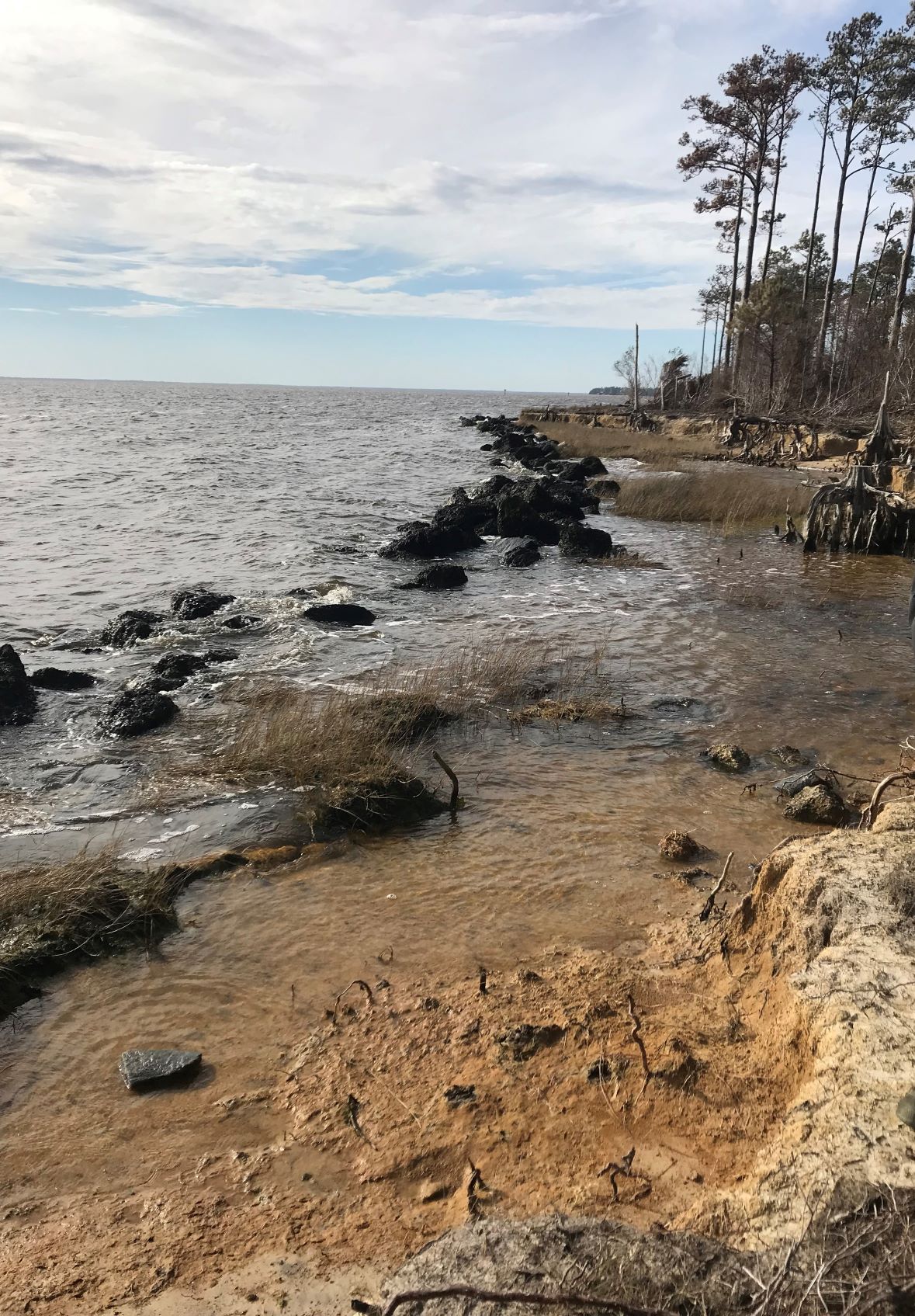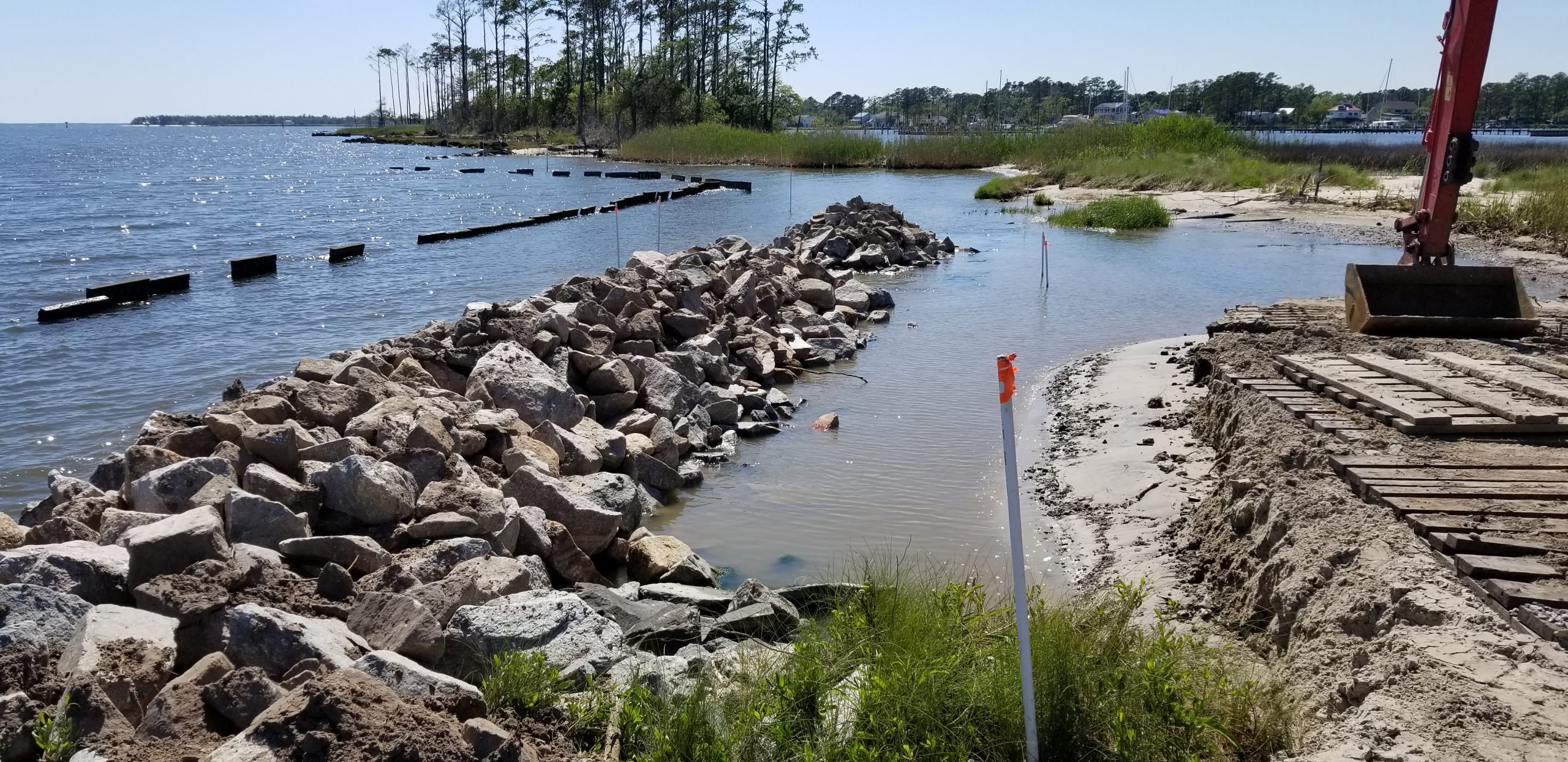OCEAN – After several years of planning, construction of the living shoreline at Whittaker Pointe in Oriental, NC has begun. The Whittaker Pointe peninsula serves as the primary defense for almost 300 town buildings, businesses and residences against the waves and surge from the Neuse River during storms and routine high wind events. Unfortunately, over 15 acres of the peninsula’s shoreline has eroded away through the years as depicted by Google Earth and National Aeronautics and Space Administration satellite imagery. This erosion has accelerated recently due to the passage of numerous hurricanes including Florence and Michael, quickly threatening exposure of the town’s infrastructure to the elements. The purpose of this new living shoreline is to protect the peninsula from future storm damage and restore lost marsh habitat.

Local geologist, Jim Blackerby, and Towndock.net brought forth the issue and the need for a solution to the attention of Town officials, residents and businesses, as well as the North Carolina Coastal Federation. Mr. Blackerby had worked previously with the federation to build a living shoreline to address erosion along several areas of Oriental waterfront. “The North Carolina Coastal Federation brings to the table a unique expertise that blends the public needs with habitat restoration,” said Mr. Blackerby.

Town Manager, Diane Miller, immediately recognized the importance of Whittaker Pointe in protecting the town and its infrastructure, and wanted to implement an effective, environmentally friendly and long-term solution to stabilize the shoreline. Support for the project was strong but funding was a challenge. She, Mr. Blackerby, and Lisa Thompson, Harbor Waterfronts Advisory Committee Chair and manager and dockmaster of Sea Harbour Yacht Club, worked with federation Coastal Scientist, Dr. Lexia Weaver, to secure funding from the National Fish and Wildlife Foundation National Coastal Resilience Fund to build a living shoreline.
Living shorelines are environmentally friendly shoreline stabilization techniques that help reduce shoreline erosion while protecting and restoring valuable salt marsh and oyster habitat at the same time. Living shorelines have proven to fare better through hurricanes and storms than bulkheads or seawalls, are less expensive, and require little to no maintenance once established.
Although the grant amount was significant, it would only help to protect a portion of the peninsula. Ms. Miller quickly worked to secure multiple matching funds from the Golden Leaf Foundation, the N.C. Department of Environmental Quality and the United States Department of Agriculture Natural Resources Conservation Service Emergency Watershed Protection Program to build the living shoreline along the entire length of the peninsula. “The Town is extremely grateful to the partners who have signed on to assist with the restoration of the Whittaker Pointe shoreline, and is excited about the progress already being made on the construction. We look forward to enjoying the protection afforded residential and commercial properties and the enhanced environment for fish and other wildlife that will once again make the restored Pointe their home,” said Ms. Miller.

The living shoreline was designed by Quible & Associates, P.C. from Powells Point, NC with structural engineering support from Gary Greene Engineers from Raleigh, NC. “The project team has been incredibly impressed by the firms’ knowledge, skills and professionalism throughout the project,” said Dr. Weaver. “We are confident that the design will result in a stronger and more productive shoreline.”
The living shoreline is being constructed by Carolina Marine Structures, also from Powells Point, NC and will consist of granite rocks placed parallel to the peninsula’s shoreline. The granite, from Wake Stone Corporation, is being transported to the site by Double A Hauling, Inc. Loose and bagged recycled oyster shells will also be placed by volunteers and Restoration Systems to protect the Whittaker Creek side of the peninsula and the site will be planted with native grasses and sedges. The living shoreline will slow down and reduce the impacts of waves, thereby restoring the marsh habitat that was lost and reducing further erosion. The project is expected to be completed by the end of the summer 2020.
